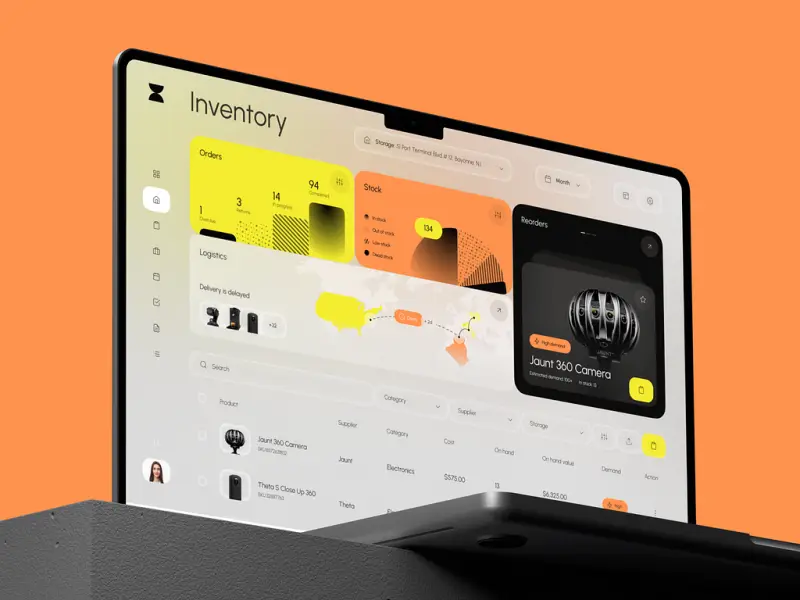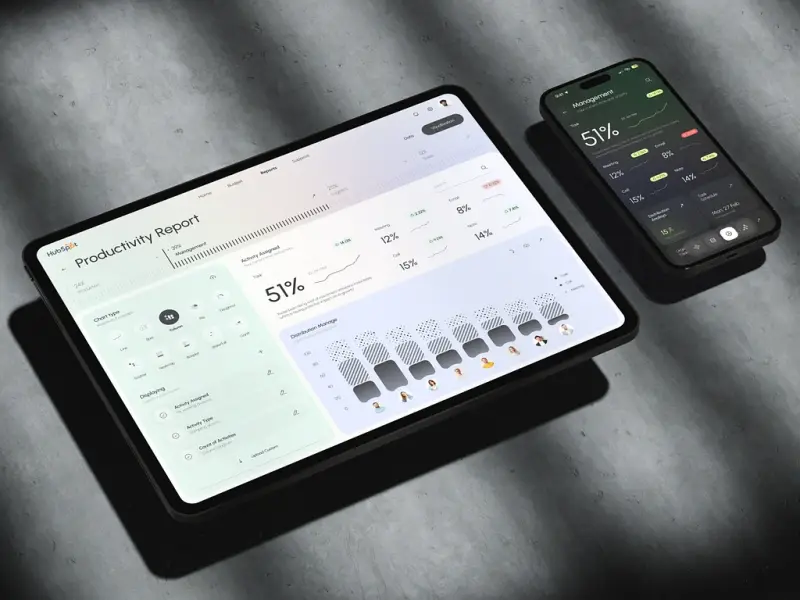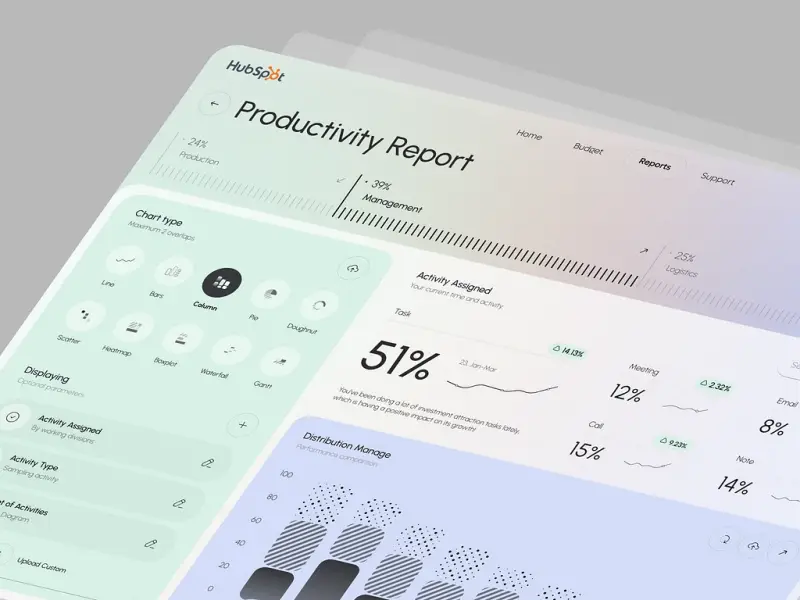How SaaS MVP Development Can Fast-Track Your Startup Growth
Finding the perfect product-market fit is one of the top challenges for early-stage and scaling startups. While it’s true that you can’t fully predict whether your SaaS solution will resonate with your target audience until it’s in their hands, you don’t have to risk everything by diving headfirst into full-scale development.
That’s where building a SaaS Minimum Viable Product (MVP) becomes your strategic advantage. With a SaaS MVP, you can offer a glimpse of your product’s potential to real users—without the need for heavy upfront investment in time, money, or resources.
The SaaS market remains a bright spot in the startup ecosystem, accounting for 26% to 32% of all venture capital investments, even in turbulent funding climates. But here’s the catch: just because you believe in your product doesn’t mean your customers will.
At TECHVIFY, we’ve witnessed this reality firsthand. Having developed numerous SaaS solutions, we understand what it takes to turn an idea into a scalable, market-ready product. In this blog, we’ll guide you through the process of SaaS MVP development, showing you how to gather actionable user feedback while minimizing costs and risks.
I. Why Build an MVP for Your SaaS Startup?
Launching a fully developed SaaS product without testing the waters can feel like gambling in today’s competitive market. Missteps can be costly, both financially and reputationally. However, by focusing on MVP development, startups position themselves strategically for long-term success. Here’s how:
1. Validate Your Idea Before Going All-In
One of the most significant advantages of building an MVP is the ability to validate your business idea early on. Instead of pouring all your resources into a full-scale launch, you can create a streamlined version of your software that highlights its core functionality.
This approach allows you to:
- Test key assumptions about your solution.
- Gauge market interest.
- Collect valuable feedback that informs your next steps.
Take Dropbox, for example. The company started with a simple landing page showcasing its concept. This minimal approach attracted early interest and validated the idea, giving the founders the confidence to move forward with development.
By leveraging an MVP, startups gain the insights needed to refine their ideas and make data-driven decisions about future investments, reducing risks while increasing the chances of success.
SaaS MVP development
2. Attract Investors with Real-World Proof
Investors gravitate toward startups that demonstrate real market potential with tangible results. That’s why an MVP is a powerful tool for securing funding—it shows you’re not just pitching a concept; you’re building a solution.
A functional MVP, even in its simplest form, acts as proof of your initiative, your product’s viability, and your understanding of customer needs. For instance, Dropbox’s early MVP didn’t just validate its idea with users—it also caught the attention of Sequoia Capital, securing the funding needed to scale.
By creating an MVP, you position your startup as one with momentum and vision, making it easier to stand out in a crowded marketplace and inspire confidence in potential investors.
Learn More On:
3. Accelerate Your Time-to-Market
In the fast-paced SaaS industry, timing is everything. A well-developed MVP allows you to enter the market quickly, seizing opportunities before competitors gain a foothold.
By focusing only on your product’s core features, you can streamline the development process and significantly reduce the time needed to launch. This not only gets your solution in front of users faster but also provides an opportunity to gather real-world feedback early.
With this iterative approach, you can refine your product in response to user needs, ensuring your solution evolves in the right direction—one step ahead of the competition.
4. Leverage the Power of Early Adopters
SaaS MVP development also opens the door to cultivating a loyal community of early adopters. These are the users who are most enthusiastic about trying new solutions and are willing to provide detailed feedback to help shape your product’s future.
Early adopters often become your strongest advocates, sharing their positive experiences and driving organic growth through word-of-mouth. For this to work, your MVP must deliver a clear value proposition through well-defined core features.
SaaS startups, by their nature, are well-positioned to gain customers quickly. By capitalizing on this momentum, you can build a solid foundation for your product’s success.
II. How to Build a SaaS MVP: A Step-by-Step Guide
Building a SaaS MVP (Minimum Viable Product) is a strategic process that allows startups to test their ideas, gather feedback, and enter the market faster—all while minimizing risk. A well-designed MVP sets the stage for scalability and long-term success by focusing on essential features and rapid prototyping.
Below is a step-by-step guide to help you navigate the development of a SaaS MVP, complete with actionable insights at every stage.
Step 1: Conduct In-Depth Market Research
Every successful SaaS MVP starts with a deep understanding of the market. This foundational step ensures that your product addresses genuine user needs and positions itself effectively within the competitive landscape.
Key Actions:
-
Identify Your Target Audience
- Define who your users are.
- Understand their pain points, preferences, and expectations.
-
Analyze the Market Environment
- Assess market size and growth potential.
- Analyze direct and indirect competitors, identifying their strengths, weaknesses, and unique offerings.
- Evaluate barriers to entry, such as regulatory requirements, operational costs, or other potential challenges.
By gathering this intelligence, you can tailor your SaaS MVP to meet market demand, focus on its strengths, and develop a strategy to mitigate external risks.
Step 2: Define Core Features and Technical Requirements
The next step is to identify the core features that will deliver value to users and solve their problems. The goal here is to prioritize what’s essential and avoid overloading your MVP with non-critical functionalities.
How to Define Features:
-
Focus on the Essentials:
List the core functionalities that directly address your users’ primary needs. -
Avoid Feature Creep:
Eliminate unnecessary features that don’t contribute to the MVP’s purpose. Keep it lean to save time and resources. -
Think Scalability:
Design features in a way that allows for future expansion. Your MVP should serve as a strong foundation for future iterations.
Establishing Technical Requirements:
Choose the right tech stack based on your product’s needs and long-term goals. A modern SaaS MVP typically uses the following technologies:
Front-End Development:
- HTML/CSS: Fundamental for page structure and design.
- JavaScript: Core scripting language for functionality.
- Frameworks: React, Vue.js, or Angular are popular for creating responsive, component-based UIs.
Back-End Development:
- Node.js: Ideal for handling asynchronous operations.
- Ruby on Rails: Known for its rapid development capabilities.
- Python (with Flask or Django): A flexible and easy-to-use option.
- Java or .NET Core: Excellent for enterprise-level scalability and security.
Database Options:
- PostgreSQL/MySQL: Reliable relational databases.
- MongoDB: Best for managing unstructured data.
- Firebase: Simple and scalable for SaaS MVPs.
Cloud Hosting and Infrastructure:
- AWS: Industry leader with extensive tools and services.
- Google Cloud Platform (GCP): Seamless integration with Google services.
- Microsoft Azure: Strong security and compatibility with the Microsoft ecosystem.
Step 3: Design the MVP Prototype
Prototyping bridges the gap between concept and development by creating a visual and functional representation of your SaaS MVP. This step allows you to gather early feedback, refine the user interface (UI), and identify potential design flaws.
What to Include in the Prototype:
- Wireframes and Mockups: Visual blueprints of your product’s layout and functionality.
- Interactive Elements: Simulate user interactions to validate design choices.
- Feedback Loops: Incorporate input from stakeholders, users, and investors.
TECHVIFY’s Advantage in Prototyping:
At TECHVIFY, we accelerate prototyping by leveraging reusable UI components and pre-configured environments. This approach helps us:
- Test individual UI elements in isolation.
- Create high-quality mockups quickly.
- Mimic production environments for realistic testing.
Step 4: Develop the MVP
Now it’s time to bring your MVP to life. This phase involves coding, integrating features, and testing for stability. An agile development approach ensures flexibility and continuous improvement throughout the process.
Development Best Practices:
- Leverage Pre-Built Tools: Use app generators and pre-built architecture to speed up development while ensuring scalability, security, and performance.
- Integrate Third-Party Tools: Enable seamless integrations with CRMs, CMSs, payment gateways (e.g., Stripe), authentication systems, and APIs.
- Prioritize Quality: Balance speed with quality by adhering to modern development standards and focusing on user experience.
SaaS MVP
Step 5: Test the MVP
Before launching, rigorous testing ensures that your SaaS MVP performs as expected and delivers a seamless experience. Testing not only identifies bugs and performance issues but also validates the overall functionality of your product.
Testing Types to Prioritize:
- Unit Testing: Verify individual components.
- End-to-End (E2E) Testing: Simulate user workflows to ensure the entire system works cohesively.
- A/B Testing: Experiment with different versions to optimize user engagement.
At TECHVIFY, we streamline testing with tools like ESLint, Prettier, and integrated testing environments, ensuring your MVP is ready for real-world use.
Step 6: Launch and Iterate
With testing complete, it’s time to release your SaaS MVP. However, instead of a full-scale launch, consider a soft launch to a smaller user group. This allows you to gather feedback, address potential issues, and fine-tune your product before a wider release.
Iteration Is Key:
The journey doesn’t end with the launch. Continuous improvement is essential to the success of any SaaS product. Feedback loops provide insights into:
- Resolving bugs and performance issues.
- Adding new features based on user needs.
- Enhancing the overall user experience.
The iterative process ensures your SaaS solution evolves to meet market demands, keeping you ahead of the competition.
III. Common Challenges of Building a SaaS MVP (And How to Overcome Them)
SaaS MVP development is no small feat. While it provides a cost-effective way to validate your idea and enter the market, the process can be riddled with challenges that, if left unresolved, can hinder progress or inflate costs. Fortunately, most of these obstacles are entirely avoidable with the right strategies in place.
Let’s explore the most common challenges faced during SaaS MVP development and how you can proactively address them to set your project on the path to success.
Broken Feedback Loops
A successful MVP thrives on feedback. It’s common to go through several iterations before reaching full development, but some companies fail to gather accurate and actionable feedback from their audience.
Solution: Build Strong Feedback Channels
Create a community of early adopters by engaging with them across multiple platforms, such as:
- Forums and social media groups.
- Surveys and email forms.
- Exploratory interviews.
Incorporate both qualitative feedback (e.g., user-friendliness) and quantitative feedback (e.g., task completion difficulty). This dual approach ensures you’re addressing usability and functionality issues effectively, helping you refine your MVP to better meet user needs.
Inefficient Development Methodology
Without a structured approach to SaaS MVP development, projects can spiral out of control—leading to missed deadlines, rising costs, and lower productivity. Shockingly, only 42% of employees report being trained in agile practices, despite evidence that agile culture can boost commercial performance by 277%.
Solution: Embrace Agile and DevOps Practices
Invest in an agile approach to increase efficiency and flexibility. Key practices include:
- Continuous Integration/Continuous Delivery (CI/CD): Automate and streamline code deployment.
- Trunk-Based Development: Reduce merge conflicts and improve collaboration.
- Quality Documentation: Improves technical capabilities and prevents burnout among teams.
- Rapid Code Reviews: Accelerate development cycles without sacrificing quality.
A strong DevOps culture is also crucial. Research indicates that flexible infrastructure improves organizational performance by 30%, while combining trunk-based development with robust documentation increases technical performance by 13x.
Neglecting Security Early On
Your SaaS MVP will likely collect sensitive user data, and neglecting security at the MVP stage can lead to costly vulnerabilities later. Yet, some startups treat security as an afterthought, leaving their product exposed to risks.
Solution: Implement Security from the Start
Adopt the DevSecOps methodology to make cybersecurity a core part of your development process. Key security measures to implement include:
- Multi-factor authentication (MFA).
- Dynamic password mechanisms.
- Data encryption for both storage and transfer.
- Role-based access control (RBAC).
Additionally, follow established security frameworks, such as ISO/IEC 27001, to ensure compliance and mitigate risks both internally and externally.
Scalability Challenges
A SaaS MVP that struggles to handle a growing user base can lead to performance issues, frustrated customers, and lost opportunities. Scalability is especially critical in the cloud environment, where SaaS solutions often experience rapid user adoption.
Solution: Leverage Scalable Cloud Infrastructure
Choose cloud platforms like Amazon Web Services (AWS), Microsoft Azure, or Google Cloud Platform (GCP) to ensure your MVP can grow alongside your user base. These platforms offer:
- Cost-effective, on-demand resource scaling.
- Built-in tools for performance monitoring and load balancing.
- Advanced analytics to track and optimize resource usage.
By designing a scalable architecture from the outset, your SaaS MVP will avoid bottlenecks and ensure a seamless user experience as your product grows.
Unrealistic Budget Estimates
Underestimating the cost of building an MVP is a common pitfall. It typically takes between $25,000 and $60,000 to develop a basic SaaS MVP, depending on the team’s expertise and location. Without proper planning, costs can quickly spiral out of control.
Solution: Plan for Realistic Budgets
When outsourcing or hiring remote teams, consider factors like:
- Hourly Rates: Vendors in the US or UK can charge up to $199/hour, while experienced developers in regions like Vietnam offer competitive rates of $10–$15/hour.
- Expertise and Workflow: Choose a team with a proven track record of delivering SaaS solutions efficiently.
Working with a dedicated team that combines cost-effectiveness with technical expertise can help you stay within budget without compromising quality.
Learn More On:
IV. 3 Proven Tips for Building a SaaS MVP
Despite the challenges, there are simple yet effective strategies to ensure your SaaS MVP succeeds. Here are three actionable tips to guide your development process:
Think About the Value Proposition
Your MVP’s value proposition is the cornerstone of its success. A clear and compelling value proposition communicates why your product deserves attention and how it solves user problems.
How to Build a Compelling Value Proposition:
- Identify the Problem: Determine the specific issue your SaaS solves.
- Highlight Your Uniqueness: Showcase what sets your MVP apart from competitors.
- Communicate Effectively: Use messaging that speaks directly to your audience’s pain points.
By clearly articulating your value, you ensure potential users understand what your solution offers and why it’s worth their time.
Building SaaS MVP
Create a Software Design Document (SDD)
A well-organized roadmap is essential for effective collaboration across teams. A Software Design Document (SDD) ensures every stakeholder—from developers to investors—understands the project’s direction and requirements.
What to Include in an SDD:
- System requirements and technical specifics.
- Key features and functionality.
- Development tools and processes.
- A timeline for deliverables.
At TECHVIFY, we use SDDs to align technical decisions with our client’s vision, ensuring clarity and improving communication throughout the development process.
Gather Feedback and Iterate
Feedback is the lifeblood of any SaaS MVP. After the initial launch, collect insights from users to refine your product and focus on the features that matter most.
Metrics to Track:
- Monthly Recurring Revenue (MRR): Measure predictable income.
- Churn Rate: Identify how many users stop using your product.
- Daily/Monthly Active Users (DAU/MAU): Track engagement levels.
- Customer Lifetime Value (CLV): Understand the long-term value of your users.
Use this data to prioritize improvements, fix pain points, and enhance your solution’s overall value proposition.
Conclusion
Building SaaS MVP solutions can seem daunting, but with the right strategy and expert guidance, you can turn challenges into opportunities. From validating your idea to scaling for growth, every step of the MVP process is critical to your product’s success. At TECHVIFY, we specialize in taking your vision and transforming it into a market-ready solution.
Now is the time to take the first step. Contact TECHVIFY today for a free consultation and let’s develop a SaaS MVP that brings your ideas to life and sets your startup on the path to success. Together, we’ll build something extraordinary.
TECHVIFY – Global AI & Software Solution Company
From Startups to Industry Leaders: TECHVIFY prioritizes results, not just deliverables. Accelerate your time to market and see ROI early with high-performing teams, AI (including GenAI) Software Solutions, and ODC (Offshore Development Center) services.
- Email: [email protected]
- Phone: (+84)24.77762.666








